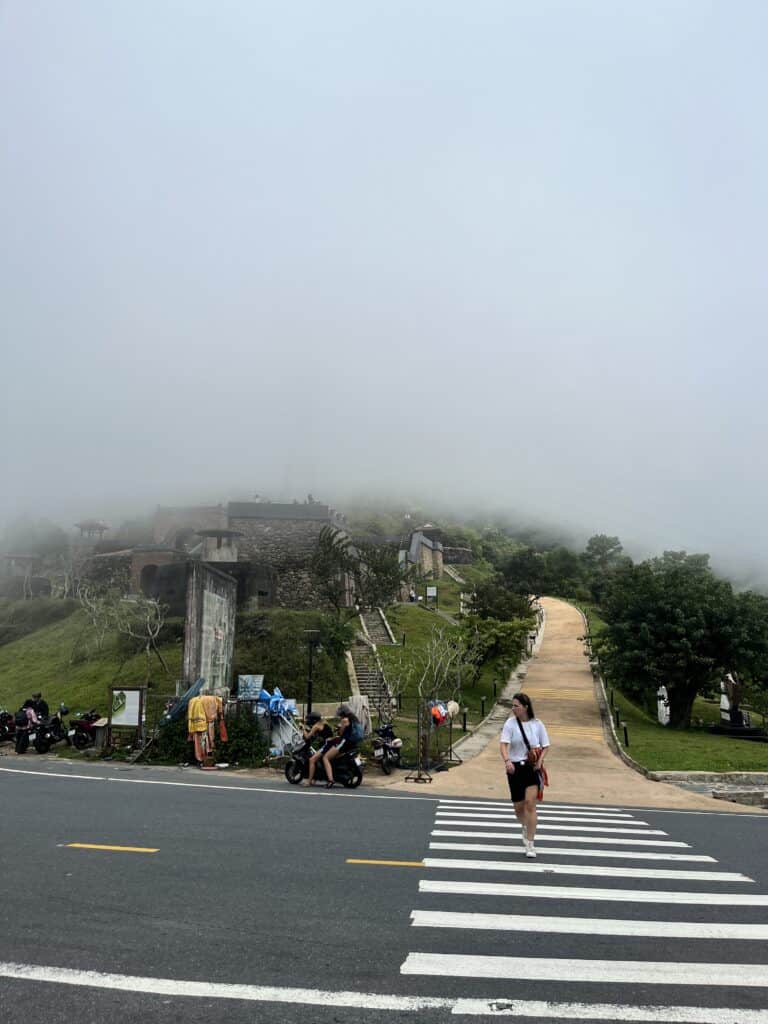Taking a trip from Da Nang to Hue offers a perfect balance between Vietnam’s modern, coastal energy and its rich imperial history. While Da Nang boasts beaches and a bustling city vibe, Hue—once the imperial capital—invites you into a world of ancient tombs, pagodas, and the tranquil flow of the Perfume River.
If you’re visiting Central Vietnam and short on time, a day trip to Hue from Da Nang is a must. With cultural sites, scenic routes, and just enough distance to feel like a journey, this quick adventure lets you dive into Vietnam’s heritage without needing an overnight stay.
Closest Airport to Hue
There are no direct flights between Da Nang and Hue as the travel distance is not a lot. The closest airport to Hue is Phu Bai International Airport, located about 15 kilometers south of the city center, with domestic flights from Ho Chi Minh City and Hanoi. If you’re arriving internationally, you’ll most likely fly into Danang Airport and then make the scenic journey to Hue.
Disclosure: This post may contain affiliate links. If you book through these links I may make a small commission at zero cost to you. It helps me pay for the upkeep of this blog. Thank you!
What is the Distance from Da Nang to Hue?
Danang and Hue are about 100 kilometers (62 miles) apart. No matter which travel option you choose, the journey itself is stunning, transitioning from Da Nang’s urban coastlines to Hue’s more serene, historical landscapes. With mountain passes and coastal views, you’ll be glad this isn’t just a quick flight.
Danang to Hue by Train – scenic
Traveling by train from Danang to Hue is a classic and scenic choice, with Vietnam Railways operating all services on this route. The journey departs from Danang Railway Station at 202 Hai Phong, Thanh Khe District, and it’s best to arrive about 30 minutes before departure time to complete boarding smoothly. Passenger cars are divided into four classes—hard seat, soft seat, soft bed (in compartments for up to four passengers), and hard bed (for up to six)—so you can choose the level of comfort that suits you best.
How Long is the Train Ride from Danang to Hue?
The train ride from Danang to Hue typically takes around 2.5 to 3 hours, but with the breathtaking landscapes along the way, time flies by. As the train hugs the mountains and winds through the coastline, you’ll pass over the famous Hai Van Pass, a stretch that alone makes the journey worthwhile. This isn’t a trip for napping—you’ll want to keep your camera ready and soak in the views from your window seat.
How to Book Train Tickets
There are three easy ways to book your train tickets in Vietnam:
1. Vietnamese Railway Website : You can book a seat online, but there’s a catch—payment must be completed in person at a train station, unless you have a Vietnamese credit card. With confirmation in hand, you can go to any station (not necessarily your departure station) to pay and collect your ticket in cash.
2. 12Go Asia Website : This international-friendly booking site accepts foreign cards and is easy to navigate. After selecting your seat, you’ll receive an e-ticket by email for a small processing fee (about $1.50). Just show the e-ticket at boarding, and you’re set.
3. In-Person at the Station: While you can buy tickets directly from the station, it’s best to avoid this during peak seasons when trains tend to sell out quickly. If you go this route, staff can usually speak enough English to help you find what you need.
Scenic Highlights by Train: Sights Along the Way
The Danang to Hue train route is renowned for its stunning coastal and mountain views. As the train snakes through Hai Van Pass, mist-shrouded mountains meet the sparkling waters of the South China Sea, with small fishing villages scattered along the shoreline. You will find yourself glued to the window as you approach Lang Co Bay, a picture-perfect stretch of turquoise waters and white sands that seemed to belong in a dream. It’s the kind of scenery that makes you appreciate the slower pace of train travel—and feel like you’re experiencing Vietnam’s landscapes in a uniquely intimate way.

Bus from Danang to Hue – budget-friendly
If you’re looking for a budget-friendly way to travel from Danang to Hue, the bus is a great choice. Buses in Vietnam offer a communal experience—expect a few snack breaks, maybe a chatty seatmate, and scenic views along the way. Here’s a quick breakdown of the types of buses you’ll find on this route:
- Public Buses: The most economical choice, catering to locals and budget-conscious travelers. Public buses are affordable and reliable, but can be crowded during peak hours.
- Tourist Buses: These buses are geared towards travelers, with amenities like air-conditioning, spacious seating, and sometimes even onboard Wi-Fi. They offer a comfortable balance of convenience and cost.
- Limousine Buses: For those looking for a more premium experience, limousine buses feature plush seating, extra legroom, and a quieter environment. These buses typically seat fewer passengers, making for a more private and relaxed journey.
Recommended Bus Companies
Several companies operate reliable services between Danang and Hue. You can probably ask your hotel/airbnb host to arrange it for you. There are hundreds of buses running between the two cities every day, catering to different budgets and comfort levels:
- Vietnam Travel Bus runs limousine-style minivans with three rows of seats, accommodating up to seven passengers. This is ideal for smaller groups or those seeking a quieter ride with more legroom.
- Hoang Duc Limousine and Huong Giang Limousine provide premium service and are well-reviewed for their attentive service and punctuality.
Ticket prices range from 100,000 to 200,000 VND ($4-8 USD), making the bus one of the most affordable ways to travel between these two cities. Most buses depart from company offices in Son Tra District, Danang; it’s best to arrive at least 60 minutes early, as some companies provide shuttle transfers to the main terminal. Buses typically arrive in Phu Hoi Ward, Hue, conveniently close to the city center.
While bus travel is the most budget friendly option, I would still recommend taking the train instead.

Danang to Hue by Bike – adventurous
The route from Danang to Hue has long been popular among bikers, especially since Top Gear’s 2008 episode called the Hai Van Pass “one of the best coast roads in the world.” Personally, I think the Hai Van Pass is a bit overhyped—it’s stunning but not necessarily the highlight of Vietnam. However, the journey offers diverse scenery, from coastal stretches to jungle-clad mountains, making it perfect for a biking adventure.
Thanks to improved roads and the growing popularity of Hoi An, Danang, and Hue, there are now four main routes to choose from, each with unique landscapes and levels of difficulty. If you’re interested in exploring Central Vietnam’s landscapes, you can even combine two or more routes to create a loop and see more without backtracking.
Four Routes to Consider
- The Coastal Route: This classic route, featuring the Hai Van Pass, is about 135km and takes around 3-5 hours. It’s ideal if you want ocean views, scenic back roads, and some iconic coastal scenery. After passing over Hai Van, the route descends to Lang Co Beach and follows quiet roads through fishing villages and alongside Lap An Lagoon, ending in the heart of Hue.
- The River Route: A newer road that bypasses both the Hai Van Pass and Tunnel, this route stretches around 125km behind Bach Ma National Park. It offers smooth roads and less traffic, taking you through river valleys and lush fields. It’s a fast and scenic option, but check ahead as two-wheel traffic may sometimes be restricted.
- The Mountain Route: For those looking to go off the beaten path, the mountain route via the Ho Chi Minh Road is the most challenging but most rewarding option. Covering 270km, it can take one to two days. This route winds through untouched rainforests, remote valleys, and ethnic villages, making it a stunning, immersive experience in Vietnam’s rugged beauty.
- The Tunnel Route: The most direct route, Highway QL1A, goes through the Hai Van Tunnel, cutting the journey down to about 95km. While convenient, this route is more functional than scenic, as motorbikes aren’t allowed in the tunnel (you’ll need to take a shuttle for about 30,000 VND). This is the fastest way to reach Hue if you’re pressed for time.
Where to Rent Bikes in Da Nang
For renting a motorbike, Hoi An Motorbike Adventures and Tigit Motorbikes (link) are both solid options. Hoi An Motorbike Adventures offers a range of rentals and one-way options to Hue, with automatic and semi-automatic bikes. Tigit Motorbikes is known for its well-maintained bikes and flexible rental policies, making it beginner-friendly. Expect to pay around 200,000 to 300,000 VND per day ($8-12 USD) for a reliable bike.

Danang to Hue Tours – convenient
If you’d prefer a hassle-free day trip from Da Nang to Hue, there are several tour options to consider, each offering a unique way to experience the journey. For those who love history and sightseeing, a Hue Imperial City Tour includes visits to iconic spots like the Imperial City, Khai Dinh Tomb, and Thien Mu Pagoda, complete with a guide who brings the history to life.
Alternatively, you could opt for the train and bus tour via the Hai Van Pass, where you’ll travel part of the way by train—giving you incredible views of the mountains and coastline—before a guided city tour in Hue. If you’re after a bit more adventure, a motorbike tour through Central Vietnam provides a thrilling way to take in the coastal and rural landscapes with an experienced guide leading the way.
These tours provide structured itineraries for a more immersive experience without the stress of planning it all yourself.
Danang to Hue by Grab
If you’re traveling with friends or just want the ease of door-to-door service, taking a Grab (Southeast Asia’s version of Uber) from Danang to Hue is both convenient and cost-effective. Expect fares around 1,000,000 VND ($40 USD) for the one-way journey.
Can You Hitchhike from Danang to Hue?
Yes, it’s possible, but not necessarily the easiest or safest option. While hitchhiking is common in some regions, it’s less so here, especially on busy roads. I’ve done it once in Vietnam, but only after my bus didn’t show up. The experience was memorable, to say the least—but I wouldn’t recommend it as a primary plan.
For more places to visit in the country check out my itinerary for Hanoi and what to do in Ninh Binh.
Final Thoughts: Is Hue Worth It?
While the Hai Van Pass is often hyped as a must-see, it can feel a bit underwhelming if you’re expecting the journey of a lifetime. But don’t let that stop you—Hue itself is a captivating destination that deserves a spot on your Vietnam itinerary. Whether you’re after stunning landscapes, historical insights, or just a scenic escape from the bustle of Da Nang, a trip to Hue offers a memorable slice of Vietnam’s heritage.
If you’re planning to spend more time in Central Vietnam, make the most of your stay by exploring all that Da Nang has to offer before or after your visit to Hue.
Frequently Asked Questions
Is Hue a day trip from Da Nang?
Yes, Hue is a popular day trip from Da Nang. Located about 100 kilometers away, it takes around 2-3 hours to reach by car, train, or bus. A day trip allows enough time to explore Hue’s main sights, such as the Imperial City, pagodas, and royal tombs.
Is it better to stay in Hue or Da Nang?
It depends on your travel style. Da Nang offers vibrant city life, beaches, and a central location for exploring nearby spots like Hoi An. Hue, on the other hand, is steeped in history and offers a quieter atmosphere with historic sites. For more variety, consider staying in Da Nang and visiting Hue as a day trip.
How much is a Grab from Da Nang to Hue?
A Grab ride from Da Nang to Hue typically costs around 1,000,000 VND (about $40 USD) for a one-way trip. This price varies based on demand, time of day, and type of vehicle chosen, making Grab a convenient and relatively affordable option for door-to-door service.
